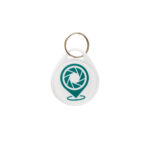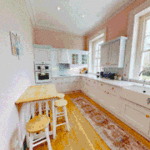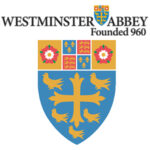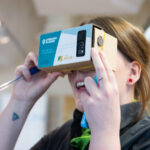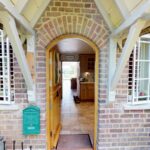Take a Virtual Tour inside Westminster Abbey
Westminster Abbey, once described as the Parish Church of the world, is a spectacular building with over 1,000 years of history. When Striking Places’ Jo Hailey got a request for more information about Google Street View Trusted Tours from Westminster Abbey you can imagine her excitement.
The site was first inhabited by Benedictine monks around 960 AD and used as a place of daily worship. Although there is no trace of the building they originally founded, Edward the Confessor built a new abbey on the site, which was consecrated, in 1065 and that is still evident.
The Abbey has been the site of every coronation since 1066 and sixteen royal weddings including that of the current Duke and Duchess of Cambridge. Of the 3,300 famous people buried there, it is the resting place of no less than seventeen monarchs. Charles Dickens and Jane Austen are buried there, as are Robert and Elizabeth Barrett Browning. There are also numerous memorials in the form of beautifully crafted statues and stones. On top of this incredible history the Abbey is home to a vast array of treasures, art, curios, textiles and pavements. The building’s outstanding architecture holds much of the nation’s history within its walls.

For some time the Education Department at Westminster Abbey had been considering how best to increase engagement and raise their profile using digital technology. There are many areas of the Abbey that, for obvious reasons, the public do not have access to, and visiting the Abbey in person is not possible for many. So how to enable people all over the globe to have access to the full glory of Westminster Abbey? Their marketing team noticed the option for a virtual tour on their Google My Business page and took this idea to the Education Department. Alasdair Wallace, Westminster Abbey’s digital marketing manager, requested more information and Striking Places’ Jo got in touch immediately and arranged a consultation.
Jo already had a special place in her heart for Westminster Abbey. Her father has been a Blue Badge Tour Guide of the Guild of Registered Tourist Guides for some 40 years standing, and his specialty was Westminster Abbey. He had spent many hours showing American tourists round the Abbey dressed in a bowler hat and traditional English garb.
In June 2015 Jo went to Westminster Abbey to meet Alasdair Wallace and Head of Education Grazyna Richmond. In any initial consultation it is necessary to fully explain just what Striking Places can do, and then the client is better able to understand the possibilities available to them. As the three of them walked through the Abbey, Alasdair and Grazyna outlined what they had in mind and Jo was able to advise them how best to achieve this with a virtual tour.
The enormity of the project, hinted at in the initial discussions, soon became very clear. From the beginning Alasdair and Grazyna were very interested in interactive overlays. These allow virtual tours to be enriched with all sorts of digital content. A navigation menu enables the viewer to get an overview and jump straight to their place of interest. The overlay also allows you to insert hotspots throughout the tour. These act as information points which when clicked on expand into a window in which you can embed videos, images or links. You can see an information point below just above the Great West Door. A good example of how much you can do with an information point is the grave of the Unknown Warrior. Click on the info point and you’ll see the history of the memorial, a link to the page about the Unknown Warrior on Westminster Abbey’s site and moving footage of the funeral of the Unknown Warrior.
Interesting Fact #11: The Grave of the Unknown Warrior – The word ‘warrior’ is used rather than ‘soldier’ since he represents all those unidentified who served and died during the First World War, in whatever capacity . ‘Warrior’ covers all of the armed forces. The Queen Mother was the first royal bride to lay her wedding bouquet on the grave, and Kate Middleton, the Duchess of Cambridge continued the tradition after her wedding. It has also become traditional for visiting dignitaries to lay a floral tribute on it.
One area that appears in the virtual tour is the fascinating Cosmati pavement. Commissioned by Henry lll and laid by Roman craftsmen in 1268, this mosaic pavement is comprised of many different coloured stones and depicts the planet surrounded by the men and animals that inhabit it. It even has a brass inscription predicting the life-span of earth, stating it to be 19,683 years. Hidden under a red carpet for over 100 years, painstaking restoration on the pavement recently took place over two years. In 2010 it was finally restored to it’s former glory.
Westminster Abbey has a huge variety of things going on there all the time. The only slot available for any kind of photography or filming there is between 7.00 am – 9.30 am on a Thursday. Competing with the demands of the BBC, Channel 4 and many others it was September before Striking Places were able to grab a morning and start shooting the tour.
Interesting Fact #66: Channel 4 were also there one morning when Striking Places were, and you can actually see Jon Snow in one of the tours. Not the one who knows nothing, the REAL Jon Snow!
Between September and Christmas Striking Places fitted in 5 sessions shooting the tour. Around the time of his 80th birthday, Jo’s dad requested being her bag carrier for one of the days, given how special the Abbey is to him, and Jo and Westminster Abbey readily agreed. He had a wonderful morning and has his very own 360 panorama by the Grave of the Unknown Warrior.
The commissioning of the tour has coincided with another exciting new project for Westminster Abbey. They are currently building a new museum and gallery, The Queen’s Diamond Jubilee Galleries, in the medieval triforium of the Abbey. The triforium is a gallery originally designed to house dedicated chapels for various saints. Running 70 ft above the floor of the Abbey it has been hidden from the public for 700 years. The museum will allow the public to view many previously unseen treasures and relics, and is planned to represent different periods of history. We will be able to extend the existing virtual tour to the new upper area using the elevator button. This inserts different levels within the tour allowing the viewer to move between floors within a building. We will also create information points that will reflect the museum’s different periods of history as it develops. The current tour took seven sessions shooting at the Abbey and months of careful processing and development. Striking Places very much look forward to the future collaboration.
The Dean of Westminster Abbey is thrilled with the project. “We have been pondering how to extend to young people and others, who cannot for the time being visit the Abbey, something of the experience available for our many visitors. I am delighted that this new collaboration will enable people from Timbuktu to Kalamazoo and beyond to see and learn so much more than previously about the magnificence and significance of this great and beautiful Church.”
Charles Armstrong, Street View Product Manager at Google, is also impressed with its success: “This beautiful collection highlights the splendor of Westminster Abbey, the value of Street View publishing, and some truly exceptional imagery on the part of the photographer. We’re delighted to see and support awareness for such powerful content.”

Interesting Fact #93: The original tomb of three-time Prime Minister to Queen Victoria, Robert Gascoyne-Cecil, the third Marquis of Salisbury, is housed in Westminster Abbey. A replica of that very tomb features in another of our historic church tours, that of St Etheldreda’s Church, which is part of the Hatfield House complex. The two buildings are both prominent in the history of the British royal family and have been closely linked since their inception.

